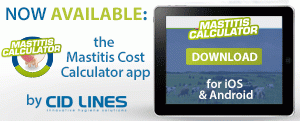Despite a good knowledge of the pathology, the cost of both clinical and subclinical mastitis is often ignored or underestimated.
If direct consequences (udder damages) and direct costs (cost of treatment, veterinarian fees and time spent to treat animals) of mastitis are obvious, undirect  consequences and costs are often neglected despite much more economical impact. The main undirect cost is the decrease of milk production for the current lactation and also, because of irreversible damages, for the next lactation.
consequences and costs are often neglected despite much more economical impact. The main undirect cost is the decrease of milk production for the current lactation and also, because of irreversible damages, for the next lactation.
Optimizing milk production and milk quality is a priority for dairy sector. Optimizing milk production means optimizing farmers’ profit. And the strongest leverage measure to achieve optimum milk production is to prevent mastitis. Think hygiene, think high gain!
Mastitis is inflammation of the mammary gland, associated with bacterial infection. It is induced when pathogenic microorganisms enter the udder through the teat canal, overcome the cow’s defence mechanisms, begin to multiply in the udder, and produce toxins that are harmful to the mammary gland. Mammary tissue is then damaged, which causes increased vascular permeability. As a result of this, milk composition is altered. The extent of these changes is determined by the severity of the infection.
CLINICAL MASTITIS
Clinical mastitis is an inflammatory response to infection causing visibly abnormal milk (eg, color, fibrin clots). As the extent of the inflammation increases, changes in the udder (swelling, heat, pain, redness) may also be apparent. Clinical cases that include local signs only are referred to as mild or moderate. If the inflammatory response includes systemic involvement (fever, anorexia, shock), the case is termed severe.
Mastitis is of great economic importance to milk producers, with both direct and indirect costs as a consequence. The economic loss from one single case of clinical mastitis in Western Europe ranges from 200-300 euros.
SUBCLINICAL MASTITIS
Mastitis can exist in the absence of visible signs of infection, and is then referred to as subclinical mastitis. Subclinical mastitis is the most prevalent form of mastitis.
Detection is best done by examination of milk for somatic cell counts using either the California Mastitis Test or automated methods provided by dairy herd improvement organizations. Somatic cell counts are positively correlated with the presence of infection. Cows with a somatic cell count of ≥ 280,000 cells/mL have a >80% chance of being infected. Likewise, the higher the somatic cell count in a herd bulk tank, the higher the prevalence of infection in the herd.
Reduced milk production constitutes the major cost component of the total economic loss caused by subclinical mastitis and it can be very expensive!

In most industrialised countries such as the US and Western Europe, the bovine mastitis is a relevant economical problem in dairy production, averaging $ 200 loss per cow per year in the US. More than the direct costs, it is the lost of production that is the most important consequence of mastitis.
 CID LINES has developped a tool, themastitis cost calculator, to determine precisely and specifically the cost of mastitis on farm level. Enter the number of clinical cases per month, the level of somatic cell count, the production level, the price of the milk and you’ll obtain the cost of mastitis for your herd. Now, we know who is your enemy. Now we can elaborate a strategy of mastitis prevention.
CID LINES has developped a tool, themastitis cost calculator, to determine precisely and specifically the cost of mastitis on farm level. Enter the number of clinical cases per month, the level of somatic cell count, the production level, the price of the milk and you’ll obtain the cost of mastitis for your herd. Now, we know who is your enemy. Now we can elaborate a strategy of mastitis prevention.
According to National Mastitis Council, the rate of new intramammary infection can be 50% lower when disinfecting teats with an effective product immediately after every milking compared to no disinfection. Teat disinfection does not affect exisiting mammary gland infections but may reduce colonization of the teat ducts. Existing infections are best eliminated by dry cow treatment and culling chronically infected cows.
Preventing new infections by using teat disinfection reduces the prevalence of mastitis in a dairy herd over the long term. Improvements, such as fewer cases of clinical mastitis and/or lower somatic cell count, generally, can be observed within a few months. Good teat disinfectants have efficacy against the major mastitis pathogens, are economical, easy to apply, and help maintain or promote a good skin condition.
